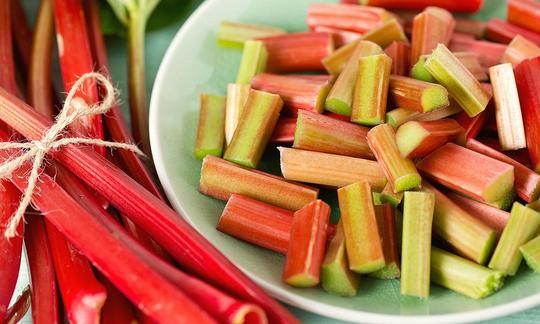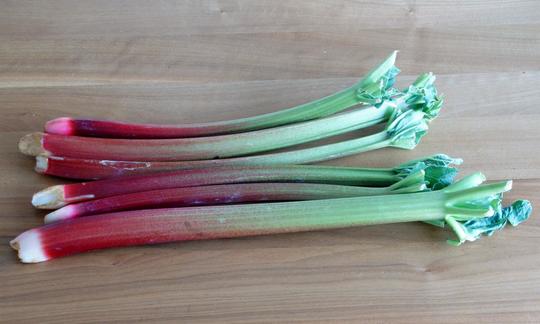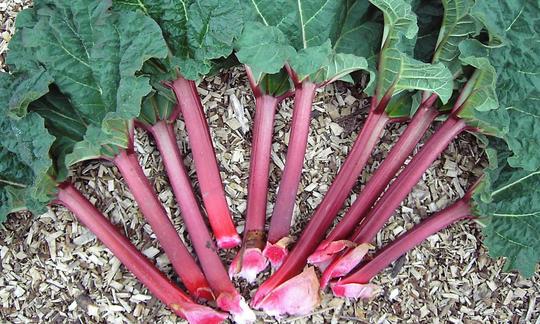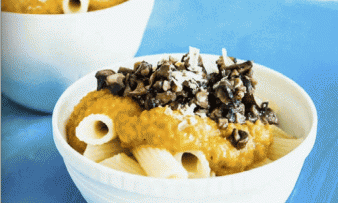Table of contents
Rhubarb ( Rheum rhabarbarum ) should be eaten cooked. If eaten raw or in large quantities, it can be dangerous.
Use in the kitchen:
Rhubarb (or vegetable rhubarb ) tastes refreshing and piquant-sour. The peeled or unpeeled leaf stalks can be cut, processed and consumed cooked, depending on the variety and age of the stalks. Many valuable ingredients are lost when vegetables are cooked. However, raw rhubarb deprives the body of important minerals such as calcium , magnesium and iron due to its high oxalic acid content. This can be dangerous under certain circumstances, especially for children or people with gallbladder or kidney diseases.
You should not use the leaves because of their high oxalic acid content.
Because of its preparation and taste, low-calorie rhubarb is generally considered a fruit, although it is actually a vegetable. The most well-known dishes made from rhubarb are jams and compotes (both of which are also made on an industrial scale), as well as cakes and muffins. Rhubarb is also pressed into juice and processed into must or ice cream. Spicy chutneys are a tasty change. Rhubarb is rarely eaten as a vegetable: the flower buds are cooked like broccoli or cauliflower . 1
The oxalic acid can be reduced either by choosing certain types of rhubarb (e.g. "Holsteiner Edelblut" with red stalks) or neutralized by using certain spices and ingredients. These are mainly lemon juice , angelica stalks, nutmeg , cloves , cinnamon and bay leaves . These spices also go well with the aroma of rhubarb. Traditional English rhubarb jams, on the other hand, are refined with ginger , oranges and arnica. 2 If you use thicker (and older, more acidic) stalks in addition to the young ones, it is an advantage to peel off the skin. This is because it contains the most oxalic acid. 3
The oxalic acid contained in rhubarb reacts with aluminum and other metals. Therefore, rhubarb should not be cooked in aluminum pots or wrapped in aluminum foil. 2 Prefer (fireproof) glass and porcelain dishes for cooking and acid-resistant plastics for storing. 3 Please throw away the cooking water and do not reuse it or drink it. Choose organic quality.
Vegan recipe for rhubarb cake:
Ingredients: 180 g vegetable margarine , 270 g whole wheat flour , 600 g organic rhubarb, 220 ml soy milk , 150 g raw cane sugar, 3 tsp baking powder , 1 pinch of salt , 2 packets of vanilla sugar or the pulp of a vanilla pod .
Preparation: To prepare, wash, peel and chop the fresh rhubarb. Beat the soft margarine with sugar, salt and vanilla sugar until fluffy. Then mix the flour with the baking powder and add to the margarine-sugar mixture together with the soy milk. Stir the entire mixture into a smooth dough and put half of it into a greased springform pan. Mix the second half with the chopped organic rhubarb and spread evenly in the springform pan. Bake the cake in a preheated oven at 170 °C top and bottom heat or 155 °C fan oven for around 60 minutes. Only remove from the pan and cut into pieces once it has cooled completely.
| Not only vegans or vegetarians should read this: Vegans often eat unhealthily. Avoidable nutritional mistakes . |
Shopping - where to buy?
The edible rhubarb stalks are usually sold decapitated and without leaves. During the season (April to June) you can find the vegetable in practically every supermarket and on the shelves of all major retailers such as Coop , Migros , Denner , Volg , Spar , Aldi , Lidl , Rewe , Edeka , Hofer etc. When choosing, make sure it is organically grown or, better yet, buy rhubarb directly from the weekly market, from the farmer or from the organic store. They usually guarantee organic quality.
Even if it is organic, you should not eat the leaves of the rhubarb. All green parts of the plant are considered poisonous due to their oxalic acid content. The oxalic acid in the stems is considered harmless if the harvest was made before mid to late June at the latest, because only after that does the oxalic acid content in the plant rise above a worrying level. 2
Found in the wild:
In contrast to Asia, rhubarb is rarely found in the wild in Europe. 4 See also the chapter "Risk of confusion" below.
Storage:
Rhubarb is best processed immediately after purchase. If you want to keep the stalks fresh for a few days, wrap them in a damp cloth and store them in a cool place. Rhubarb can also be frozen raw. It will keep for about a year when frozen. 5
Ingredients - nutritional value - calories:
Rhubarb has a very low calorie content (21 kcal/100g) and contains, among other things, potassium , iron, vitamins K and C as well as dietary fibre6 (see nutrient table in CLICK FOR). At 29 µg/100g, the vitamin K content is comparable to that of raw celery or alfalfa and a little higher than that of turnip greens, sauerkraut and peas . Kiwi , celeriac and asparagus , for example, have more vitamin K (all approx. 40 µg/100g), and significantly more can be found in broccoli (approx. 100 µg/100g), spinach (approx. 483 µg/100g) and kale (approx. 705 µg/100g). A natural and balanced vegan diet more than adequately covers the vitamin K requirement.
Fruit acids, especially malic acid, citric acid and oxalic acid, are important for the taste of rhubarb. Varieties with red stem pulp have fewer fruit acids than those with green. The stem contains an average of 460 milligrams of oxalic acid per 100 grams 7 , and more in the leaves 4 .
Health aspects - effects:
Despite the oxalic acid content, rhubarb is healthy when cooked, preferably peeled, and consumed in moderation. The plant has a blood-purifying and intestinal-regulating effect, which is why it is recommended for detoxification treatments. 3 Consumption is not recommended for small children and people with certain illnesses (see next chapter).
Dangers - intolerances - side effects:
Oxalic acid is found in large quantities in rhubarb and other knotweed plants (such as sorrel). Star fruits are also rich in oxalic acid. Similar quantities are found in wood sorrel ( Oxalis ), chard , spinach, parsley , cocoa , chocolate and beetroot . Many fungi also excrete oxalic acid.
The oxalic acid in rhubarb depletes calcium in humans and binds to iron and magnesium. Our body excretes the oxalic acid through the kidneys. If crystals form from the body's own calcium and oxalic acid, kidney or bladder stones can develop. People with kidney and gallbladder disease and children (with an increased need for calcium) should therefore be careful. 7 Since oxalic acid makes it difficult for the intestines to absorb iron, iron therapy should avoid foods that contain a high amount of oxalic acid. 8
In breastfeeding mothers, components of rhubarb pass into the milk and have a mild laxative effect on the infant. 3
Eating too much raw rhubarb can lead to stomach pain and symptoms of poisoning such as cramps and circulatory problems. However, the lethal dose for an adult weighing 60 kg is more than 7 kg of raw rhubarb (600 mg per kilogram of body weight). 8
Use as a medicinal plant:
The edible variant of rhubarb is a hybridization of the species Rheum rhabarbarum from the 19th century. The roots of the edible rhubarb are not used as a medicinal plant. 9,10
The rhubarb species Rheum officinale and Rheum palmatum , on the other hand, do. The roots of this medicinal rhubarb are a well-known laxative in Chinese medicine. The root contains laxative anthraquinone glycosides. Be careful, the leaves are poisonous! It is a bitter, cooling herb that, depending on the dosage, promotes digestion, stimulates the uterus and has a laxative effect. 9
Occurrence - Origin:
The genus Rheum (rhubarb) has around 60 species and is widespread in Asia. Rhubarb originally comes from Central Asia 4 . Edible rhubarb ( Rheum rhabarbarum , also known as common rhubarb , vegetable rhubarb or curly rhubarb) grows wild in Central Asia, from eastern Siberia through Mongolia to the Chinese provinces. 11 Today, rhubarb is grown in all temperate zones of the world. In Europe, mainly in the Netherlands, England and Germany. Some tropical and subtropical countries now also cultivate rhubarb. 12 However, it is rarely organic.
Growing in the garden or as a potted plant:
Rhubarb is an uncomplicated garden plant. It is best to plant rhubarb in late autumn or at the beginning of the year. Where do I plant rhubarb? Rhubarb needs a partially shaded location and deep garden soil. It thrives near a compost heap. The varieties "Holsteiner Blut" and "Sutton" are recommended for the garden.
How long can you harvest rhubarb? The ideal harvest time is before mid to late June, so that the oxalic acid content is not too concentrated. From July onwards, the plant begins a necessary regeneration phase. It disappears into the ground over the winter, but sprouts again at the beginning of the year. 5
The deadline for the last harvest, June 24th (St. John's Day), goes back to a farmer's rule. This "lottery day" is traditionally considered to be an indication of the weather for the coming harvest season. This day is also known for the latest date for hay harvesting and the last asparagus harvest. This ensures that the plants have enough time to regenerate and gather enough strength for the next year.
The perennial grows well in mixed culture with neighbors such as peas , beans , spinach,lettuce and kohlrabi .
Even if you have grown your own organic rhubarb, please remove all leaves (which contain a lot of oxalic acid) before you put it in the kitchen.
Danger of confusion:
Wild rhubarb should not be confused with the visually similar "wild rhubarb", i.e. butterbur (common butterbur, lat. Petasites hybridus) ! Wikipedia warns against making tea from butterbur because the plant in its natural state contains substances with mutagenic, carcinogenic and possibly toxic effects on the liver. 13
General information:
Rhubarb ( Rheum ) is a genus of plants within the knotweed family (Polygonaceae).
The name rhubarb ( Rheum rhabarbarum ) is derived from the Latin word rhabarbarum (also reubarbarum) and probably refers to a type of Rheum cultivated on the Black Sea coast. Reu barbarum could therefore mean foreign Rheum . 7 The term used to refer to "Rha", an old name for the Volga, since the main cultivation area of the plant in ancient times was said to have been at the mouth of the Volga. 11,16
Medicinal rhubarb ( Rheum officinale and Rheum palmatum ) thrives in Tibet and China, but is now also cultivated in Austria and southern Germany. 3 It is one of the most commonly used Chinese medicinal plants and has been a valuable commodity since ancient times. In the Middle Ages, the dried roots of this medicinal plant were exported along the caravan routes. Depending on the stopover, the root was called "Turkish", "Russian", "East Indian" or "Chinese rhubarb". 14 Transport from China took a long time and was accordingly expensive. It is therefore assumed that medicinal rhubarb was rarely found in Europe at that time. This did not change in the following centuries, because first a Chinese and then a Russian trade monopoly prevented free transport to the West until the 19th century. 15 From the 18th century onwards, the English in particular cultivated medicinal rhubarb very diligently. 9
Alternative names:
In English, rhubarb is known as rhubarb.
Keywords for use:
The food industry uses the extract of medicinal rhubarb (without its bitter substances) as a food flavoring and as a tanning agent.
Literature - Sources:
Bibliography - 15 Sources
| 1. | hauenstein-rafz.ch/de /pflanzenwelt /pflanzenportrait /obst_beeren /Rhabarber-Rheum-rhabarbarum.php |
| 2. | lexikon.huettenhilfe.de /obst/rhabarber.html |
| 3. | Gesundheitsnachrichten / A. Vogel. 1998; Bd. 55 (5). DOI: 10.5169 /seals-557926 |
| 4. | Institut für Veterinärpharmakologie und ‑toxikologie vetpharm.uzh.ch /wir/PFLA0000/0024__F.htm |
| 5. | freundin.de /kochen-diaet-kochen-diaet-rhabarber-genuss-12541.html |
| 7. | Wikipedia Gemeiner Rhabarber. |
| 8. | Wikipedia Oxalsäure. |
| 9. | Brown D. The Royal Horticultural Society Encyclopedia of Herbs & Their Uses. London: Dorling Kindersley; 1995. |
| 10. | Wikipedia Englisch Rhubarb. |
| 11. | Wikipedia: Rhabarber (Gattung). |
| 12. | lebensmittellexikon.de /r0001170.php#4 |
| 13. | Wikipedia Gewöhnliche Pestwurz. |
| 14. | botanical.com /botanical/mgmh/r /rhubar14.htm |
| 15. | Flückiger F.A. Pharmakognosie des Pflanzenreiches. 2. Auflage, Berlin: Rudolf Gärtner; 1881: 379–380. archive.org /stream/b2810867x#page /379/mode/1up |
| 16. | Digitales Wörterbuch der Deutschen Sprache dwds.de/wb/Rhabarber |













Comments